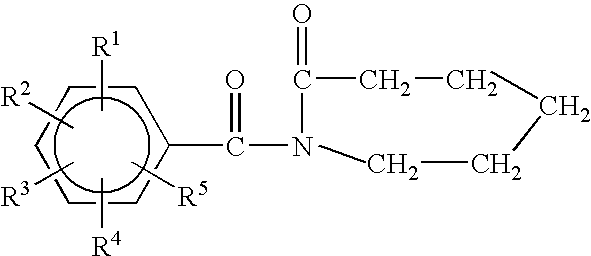Methods of protecting glassware surfaces from corrosion using detergent compositions containing polyvalent metal compounds and high levels of low foaming, nonionic surfactants
a technology of polyvalent metal compounds and detergent compositions, applied in the direction of surface-active detergent compositions, organic/inorganic per-compound compounding agents, non-ionic surface active compounds, etc., can solve the problems of glassware surface damage, glassware surface corrosion problem, surface degradation, etc., and achieve low foaming high levels
- Summary
- Abstract
- Description
- Claims
- Application Information
AI Technical Summary
Benefits of technology
Problems solved by technology
Method used
Image
Examples
examples
[0087] The following examples of ADW detergent compositions are provided for purposes of showing certain embodiments, and as such are not intended to be limiting in any manner.
EXAMPLESIngredients12345STPP / SKTP / KTPP33.033.033.033.430.7Sodium citrate————33.6Hydrozincite0.10.10.10.10.1Sodium carbonate19.019.028.026.0—Sodium silicate7.87.84.24.3—LFNI surfactant18108810Dispersant polymer——4.3——Sodium hypochlorite———1.1—Sodium perborate12.812.89.3——Catalyst / activator20.0130.0130.013——Protease enzyme2.22.20.3—1.3Amylase enzyme1.71.70.9—0.2Aesthetic enhancingBalanceBalanceBalanceBalanceBalanceagents / Fillers / Water
1POLY-TERGENT ® SLF-18B by Olin Corporation
2Pentamine acetate cobalt (III) / sodium nonanoyloxybenzene sulfonate
[0088] With reference to the polymers described herein, the term weight-average molecular weight is the weight-average molecular weight as determined using gel permeation chromatography according to the protocol found in Colloids and Surfaces, Physico Chemical & Engineer...
PUM
| Property | Measurement | Unit |
|---|---|---|
| cloud point | aaaaa | aaaaa |
| particle size | aaaaa | aaaaa |
| particle size distribution | aaaaa | aaaaa |
Abstract
Description
Claims
Application Information
 Login to View More
Login to View More - R&D
- Intellectual Property
- Life Sciences
- Materials
- Tech Scout
- Unparalleled Data Quality
- Higher Quality Content
- 60% Fewer Hallucinations
Browse by: Latest US Patents, China's latest patents, Technical Efficacy Thesaurus, Application Domain, Technology Topic, Popular Technical Reports.
© 2025 PatSnap. All rights reserved.Legal|Privacy policy|Modern Slavery Act Transparency Statement|Sitemap|About US| Contact US: help@patsnap.com


